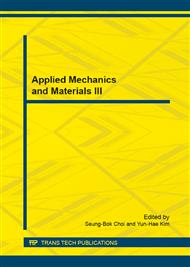[1]
WeiLiang Ruan. Preparation and Gas-sensing Properties of Zn-Al Metal Oxide[D]. University of Jinan, 2012. (In Chinese).
Google Scholar
[2]
Xiaojuan Zhang, Jing-jing Wang, Shigang Dong, Changjian Lin. Multifunctional Corrosion Inhibition Behavior of Zn-Al Calcined Layered Double Hydroxides for Steel Rebar in NaCl Solution [J]. JOURNAL OF ELECTROCHEMISTRY, 2013, 03: 256-261. (In Chinese).
Google Scholar
[3]
Sun Y Y, Zeng X B, Bai L Y.Adsorption of arsenate from aqueous solution by Mg /Al layered double oxide [J]. Acta Scientiae Circumstantiae, 2011, 07: 1377-1385. (In Chinese).
Google Scholar
[4]
Cai fang Li, Ruibin Tang, Xiuzhi Chen, Huaifa Wang. Study on the physical and chemical characteristics of D113 ion exchange resin [J]. Indust rial Water Treatment, 2001, 21(4): 11-13. (In Chinese).
Google Scholar
[5]
Liang Li. Exchanging Characteristic and Application of D113 Acrylic Acid Series [J]. Electric Power Survey & Design, 2004; 1: 68-71(In Chinese).
Google Scholar
[6]
GODE F, PEHLIVAN E. Removal of chromium (Ⅲ) from aqueous solutions using Lewatit S 100: The effect of pH, time, metal concentration and temperature [J]. Journal of Hazardous Materials, 2006, B136: 330-337.
DOI: 10.1016/j.jhazmat.2005.12.021
Google Scholar
[7]
WEI J F, WANG Z P, ZHANG J, WU YY, ZHNG Z P, XIONG C H. The preparation and the application of grafted polytetra fluoroethylene fiber as a cation exchanger for adsorption of heavy metals [J]. Reactive & Functional Polymers, 2005, 65: 127-134.
DOI: 10.1016/j.reactfunctpolym.2005.01.009
Google Scholar
[8]
CHEN Y Y, ZHAO Y. Synthesis and characterization of polyacrylonitrile-2-thiazoline resin and its sorption behavior for noble metal ions [J]. Reactive & Functional Polymers, 2003, 55(1): 89-98.
DOI: 10.1016/s1381-5148(02)00218-3
Google Scholar
[9]
Chunhua Xiong, Caiping Yao. Sorption behavior of weak acid resin ( D113 ) for Zinc(Ⅱ) [J]. The Chinese Journal of Nonferrous Metals, 2008, 18(4): 745-749. (In Chinese).
Google Scholar
[10]
Li Song, Xiaoyan Shi, Feng Pei, Jian Wu, Xianqi Deng. Discussions on selectivity coefficient of ion exchange resin and application to mixed beds operation of condensate polishing [J]. Cleaning World, 2010, 12: 33-39. (In Chinese).
Google Scholar


